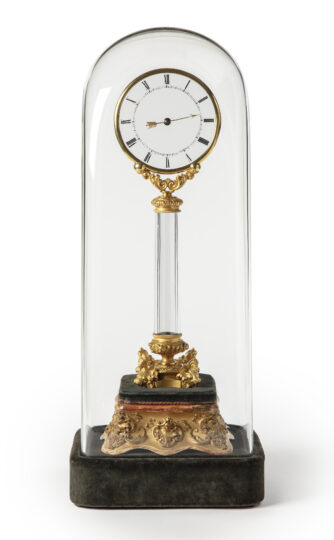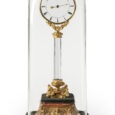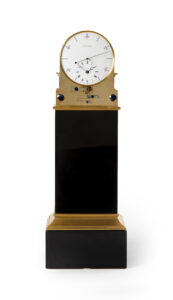MYSTERY CLOCK Attributed to: Robert Houdin à Paris Ca. 1850 France
M&R83
MYSTERY CLOCK
Attributed to: Robert Houdin à Paris
Circa 1850
France
Movement
Round brass, pillar plated movement with balance. Striking work on count-wheel striking the hours and one strike on the half-hour. The bell is placed behind the movement. The going and striking trains are driven by barrel.
Dial-plate
Concealed within the bezel is a very fine wheel which is cemented to the edge of a circular glass plate on which the hour hand is mounted and thus carried around. The glass dial bearing the black Roman numerals and is mounted in front of this. It has quarter hour divisions which are sub-divided into three.
Case
The bezel is connected with a glass column. The column contains a second inner glass column which provides the link with the movement below and the gilt brass bezel above. The glass column is resting on a decorative gilt base with a velvet cushion and containing the movement. The base is set on an ebonised base with bun feet.
Duration 1 week.
Height clock 50 cm.
Dome:
Height 54 cm.
Width 22 cm.
Depth 17 cm.
Literature
– Derek Roberts, Mystery, Novelty & Fantasy clocks, chapter 19.
– Klaus Maurice, Antique clocks/Schöne Uhren, pp. 110 – 111.
– Herve Chayette, 4 juillet 1989, pp. 54 en 55.
– Tardy, Dictionnaire des Horlogers Français, pp. 300.
Houdin
Jean-Eugène Robert Houdin was the son of a watchmaker and was born in Blois in 1805. He was both a watchmaker and a famous magician. From 1845 to 1852 he had his own theater in the Palais Royal in Paris where he organized ‘Soirées fantastiques’. For this he built several automatons to perform his tricks. He was one of the first to use hydraulic, magnetic and electrical effects for his tricks. Many of his inventions were patented. In 1830 he married the daughter of watchmaker Jacques-François Houdin (1783-1860) in Paris and took his father-in-law’s name because he greatly admired him.
In the ‘Moniteur Universel’ of June 6, 1839, ‘La Pendule Mystérieuse’ was mentioned as a remarkable object at an exhibition of French products in Paris. There are different versions of ‘La Pendule Mystérieuse’. The name Robert Houdin was printed in color on the glass dial, which was common at the time. He retired to Saint-Gervais and died there in 1871.
















